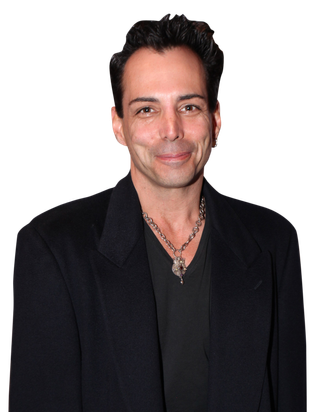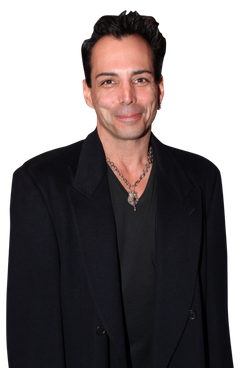

The Showtime reality series Gigolos (Thursdays at 11 p.m.), which traces the lives of four poorly dressed male prostitutes with bad tattoos, inspires a lot of double-takes from the viewer. They’re caused by the full-frontal nudity and the awkward, graphic hookups with and allegedly paid for by women, but the biggest “Whaaa?” comes during the credits, when it lists Richard Grieco as executive producer. Yes, it’s the same torn-jeans-wearing Richard Grieco who starred alongside Johnny Depp on 21 Jump Street, then moved on to the spinoff Booker, then such movies as Evil Breed: The Legend of Samhain and the upcoming Mighty Thor. (Not the Marvel version, mind you, but rather an independent version that premieres on the Syfy channel on May 7.) We caught up with the 46-year-old hyphenate and discussed his arc from model to TV heartthrob to producer to expressionist painter.
Why Gigolos?
I was sick and tired of seeing shows that were just about women. And women pleasing men. Gigolos are part of our pop culture. The only thing that has been done about it was American Gigolo. It’s been taboo. To me it was like, why?
In Gigolos, we see male prostitutes hooking up with their female clientele. I thought hustlers were for gay guys these days.
Women are making as much money as guys and want something easy-breezy, nice and easy, and no strings attached. It was a show I thought needed to be done.
What are Showtime’s rules on nudity? There is full-frontal male nudity on your show, but no erections.
There are a lot of loopholes. You can show frontal nudity, but you can’t show a fucking hard-on. There is a double standard. You can show women. I wanted to break a barrier.
Why do the female clients agree to get filmed having sex with prostitutes? Do they get it for free?
I’m not too sure. I leave that to the business people. But I know when you mention TV, you would be surprised at how many people will do it. Remember the one couple who wanted to watch his wife getting fucked by Jimmy? He was classic. “Spank that bitch!” People do this stuff.
That spanking scene was a crazy exchange. But the next episode trumped that when all four hustlers shagged that nurse at the same time.
She was crazy. She’d never done it before, it was a fantasy, like opening Pandora’s box. “I want this guy in here and this guy in here, and I wanna blow this guy.” It was a rockin’ episode.
You have often played a Lothario type. Were you drawn to Gigolos because you could see some of yourself in these guys?
Metaphorically maybe. I played a gigolo in a couple of movies, like in Heaven or Vegas with Yasmine Bleeth. I put it in the perspective of, “We’re actors, we get paid to do stuff anyways, so we are whores.”
Before acting you were a model.
I was picked out of Connecticut by Elite and started modeling and bartending at the Palladium. I was one of the original bartenders there. We were making two grand a night at gay night. It was great. It was ‘85 or ‘86.
In your modeling days, did anyone offer to pay you for sex?
Oh God, hell yeah. I never did it. I was offered five, ten grand by a guy at the Palladium.
Are you sure you didn’t do it? No judgments here!
Never did it.
Looking at images of you on 21 Jump Street and the way you look now, you have a very similar style. Did that character get his look from you or vice versa?
I’ve been this way since I was 15 years old. I wore ripped jeans and headbands before people wore that. I’ve been this guy ever since. Right now I have on ripped jeans, work boots, and a leather jacket. And the same friggin’ chain from Booker. When I did Jump Street, I created that character; it was all me. I walked in and was just me. I could get out of bed and walk on set and be dressed.
Was it easy to poke fun at yourself in Night at the Roxbury?
I gained 40 pounds for that film. I wanted to be Richard Grieco eight years down the road — partying, hanging out — and Amy Heckerling thought it was a great idea. It was fun gaining the weight; hell losing it.
How long have you been a painter?
I’ve done it for 25 years. A year and a half ago, I posted some on Facebook and it took off worldwide. When you paint from the subtext of the subconscious and it’s not literal, people gravitate to it like it’s almost painted for them. Everyone wants me to do gallery shows. But what I have gotten from this is, when I speak to people about a piece, let’s say, On The Edge of Sanity Bluff — I’ve had some buyers who have bought a new house just for that piece. It affects their lives in a positive way. If I start doing gallery shows, I fear it will just turn into a business. I paint on the ground. I paint with sticks, with big paint cans, and whatever else falls in it. Basically, what I’m doing is capturing unbridled emotion and putting it on canvas. It’s like capturing lightning in a bottle.
You paint and produce and act, but what is your main focus?
It is all a realm of consciousness of me. I have to be doing something constantly. With my artwork, I should be filmed. I paint with work boots on; I paint naked, with a fur coat on. I’ve been doing music for years; I released an album in Europe. I’m an actor and also a producer a painter and a writer.
You’re a renaissance man.
I always considered myself a painter. It is cathartic for me to see people and what they get from the piece; it’s so rewarding to see them cry and how it’s changed their life. It makes me feel amazing.

